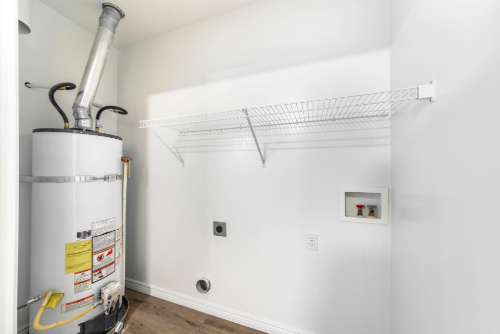Water Heater Maintenance: What You Need to Know

Everything You Need to Know About Maintaining Your Tanked Water Heater
A hot water heater is one of those appliances most homeowners barely think about — until something goes wrong. If you have a traditional tanked water heater, it quietly works behind the scenes to deliver hot showers, warm dishwater, and cozy laundry days. But like any hardworking machine, a tanked water heater needs a little attention to keep running at its best.
In this blog, we’ll walk you through everything you need to know about tanked water heaters, including life expectancy, common maintenance tasks, and pro tips to help you avoid costly repairs and early replacement. If you have a tankless water heater, check out our how-to guide for maintenance on tankless water heaters.
How Long Should a Tanked Water Heater Last?
Most traditional tanked water heaters last about 8 to 12 years with normal use. However, with regular maintenance, some can continue operating well beyond that — 15 years or more isn't unheard of.
Several factors affect lifespan:
- Water quality (hard water causes more buildup)
- Frequency of use
- Installation quality
- Routine maintenance
- Type of anode rod and tank lining
The good news is that a few simple steps each year can help you stretch the life of your tanked water heater — and maximize your investment.
Key Maintenance Tasks for Tanked Water Heaters
1. Flush the Tank Annually
Over time, sediment and mineral buildup from your water supply settles at the bottom of the tank. This sediment insulates the heating element from the water, making the heater work harder and less efficiently — and eventually leading to damage.
How to flush your tanked water heater:
- Turn off the heater (and gas supply if it’s gas-powered).
- Connect a garden hose to the tank’s drain valve.
- Open the valve and let the water (and sediment) drain completely.
- Once empty, briefly open the cold water supply to stir up any remaining sediment, then drain again.
- Close the valve, remove the hose, and refill the tank.
Tip: Some plumbers recommend flushing twice a year if you have hard water.
2. Inspect and Replace the Anode Rod
The anode rod is a sacrificial metal rod inside your tanked water heater that protects the tank from rust. It slowly corrodes over time instead of the tank walls.
When to check:
- Inspect every 2 to 3 years (or yearly in areas with very hard water).
- Replace the rod if it's more than 50% corroded or coated in calcium.
Neglecting the anode rod can lead to premature tank failure due to internal rust.
3. Check the Pressure Relief Valve
The temperature and pressure (T&P) relief valve is a critical safety device that releases water if the tank becomes over-pressurized.
Test it once a year:
- Gently lift the lever on the valve (located near the top or side of the tank).
- Water should rush out the discharge pipe.
- If it doesn’t, or if it leaks afterward, replace the valve.
4. Set the Temperature Properly
For efficiency and safety, set your tanked water heater thermostat to about 120°F. Higher temperatures increase the risk of scalding and accelerate mineral buildup.
Bonus: Lower temps also save energy and lower your utility bills!
5. Insulate the Tank and Pipes
Wrapping your tanked water heater and first few feet of exposed hot water pipes with insulation can:
- Reduce standby heat loss
- Improve energy efficiency by up to 9%
- Lower your water heating costs by 4–9%
Use a water heater insulation blanket rated for your tank size and style (especially if it’s located in a cold garage or basement).
6. Keep the Area Around the Heater Clear
Maintain at least 2 feet of clearance around your tanked water heater, especially near combustion vents (for gas heaters). Keeping the area clear helps ensure proper airflow, prevents overheating, and makes inspections and servicing easier.
Signs It Might Be Time for Replacement
Even with perfect maintenance, all tanked water heaters eventually wear out. Look for these warning signs:
- Water doesn’t stay hot
- Rumbling or popping noises
- Rusty water
- Leaks around the tank
- Visible rust or corrosion on the tank body
- Repeated repairs
If your heater is over 10 years old and showing any of these symptoms, it might be more cost-effective to replace it rather than repair.
Pro Tips for Homeowners
- Record maintenance dates so you can track when you last flushed the tank or checked the anode rod.
- Install a leak detection alarm near the heater to catch small leaks before they become big problems.
- Use a drip pan under the heater if located in or near finished spaces (some local codes require it).
- Consider a water softener if your area has very hard water — it can dramatically reduce sediment buildup.
Final Thoughts
With a little annual care, your tanked water heater can serve you faithfully for many years. Flushing the tank, checking the anode rod, and staying alert to early warning signs are the best ways to avoid sudden failures — and expensive emergencies.
Just remember: tanked water heaters don’t usually fail all at once. Small issues tend to build up over time. Stay proactive, and you’ll be rewarded with reliable hot water and not having to call in the professionals for a major issue.
